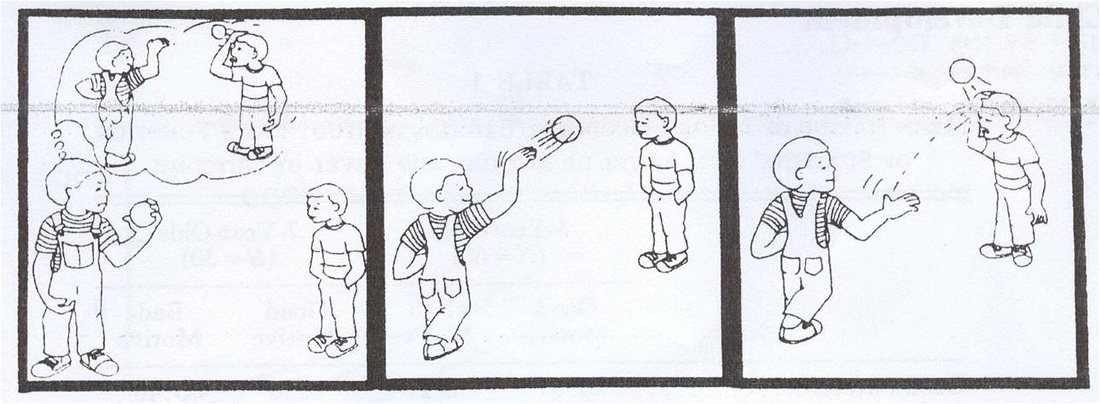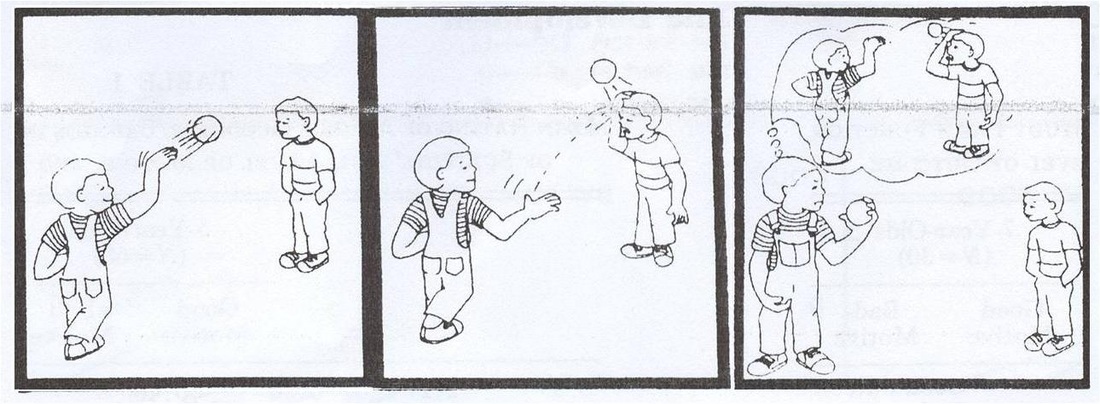Psychology: Developmental psychology: Factors influencing young children's use of motives and outcomes as moral criteria
Author: Nelson (1980)
Key term: Children's morals
Background/context:
Key term: Children's morals
Background/context:
- Piaget proposed that children go through 3 stages of moral development:
-Pre-moral stage: No morals, just instinct, from birth to 4-6 years
-Heteronomous morality: Moral is the rule, 6 - 10 years
-Autonomous morality: Set of individual morals, 10+ - Morality: Ability to distinguish right from wrong.
- Piaget proposed that children under 10 based their judgement on the outcome (negative/positive) instead of intention (motives).
- However, Nelson suggests that in Piaget's study the children did not fully understand the story, and if the child understands the story (eg. by including pictures), then they can understand motive as well as outcome.
Aim/hypothesis: To prove that children as young as 3 years do take into account both motive and outcome when making moral judgements.
Method: Field experiment in school, involving an interview.
Study 1
Variables:
Independent variables:
- Age: 3-4 years or 6-8 years
- Motive (good or bad) and outcome (good or bad)
Stories:
-Boy playing with ball. Wants friend to join in (good motive). Boy throws ball to friend to start game of catch. Friend catches ball and game of catch begins (good outcome).
-Boy playing with ball. Wants friend to join in (good motive). Boy throws ball to friend to start game of catch. Ball hits friend on head and makes him cry (bad outcome).
-Boy playing with ball. Mad at friend, throws ball to hit him on the head (bad motive). Friend catches ball and game of catch begins (good outcome).
-Boy playing with ball. Mad at friend, throws ball to hit him on the head (bad motive). Ball hits friend on head and makes him cry (bad outcome). - Mode of presentation:
Verbal only: Stories described to each child verbally (as done by piaget).
Motive implicit: Set of cartoon-like pictures with the positive and negative motives only implied by facial expressions.
Motive explicit: Set of cartoon-like pictures with positive and negative motives shown explicitly by cartoon-like thought bubbles above the characters head showing his motive.
 Motive explicit story board. Bad motive bad outcome story.
Motive explicit story board. Bad motive bad outcome story. Dependent variable: Judgement of whether the boy in the story was a 'good boy' or a 'bad boy' by the child. This was done by a scale of 7 faces, from a sad 'very bad' face to a happy 'very good' face. Both sets of good/bad smileys were 7.5cm (very good/bad), 6.5cm (good/bad) and 5.5cm (little bit bad/ little bit good). There was a 'neutral' 4.5cm face in the middle for 'just okay'.
 Scale of smiley faces.
Scale of smiley faces.Design: Independent groups for age and mode of presentation. Motive and outcome were repeated measures because kids were shown all four stories.
Setting: Schools in and around Illinois, Chicago, USA.
Participants and sampling technique: Study 1: 60 preschool kids aged 3-4 (average age 3.4 years) and 30 kids aged 6-8 (average age 7.4 years). Half male half female. Parents gave consent for them to be in the experiment.
Apparatus: 4 stories of cartoon-like pictures. Pictures were 25 x 23 cm black and white line drawings.
- Motive implicit: Only facial expressions
- Motive explicit: Thought bubble showing character's intentions (motives).
- Verbal only: Just verbal description of story.
Controls:
- Each child had 4 stories.
- Same experimenter tested every child.
- Cartoons were all the same, in a standard format.
- Children told they would have to repeat the story later so they pay close attention to the story.
Procedure:
- Children in each age group randomly assigned mode of presentation; verbal only, motive implicit and motive explicit. Split evenly - 20 kids in each verbal, motive implicit and motive explicit preschool group, and 10 kids in each for the older group.
- Children were each interviewed individually by experimenter and familiarized with the rating scale (7 smiley faces) by being given 2 practice stories.
- Children were told to listen to each story then point to which face that showed how good or bad the boy was.
- After the child made their judgement, pictures were removed in the picture condition groups and child was asked to repeat the story the experimenter told. If the motive or outcome was missing, the experimenter would ask specific questions such as "Why did the boy throw the ball?".
Data:
- Quantitative data: A number was allocated to each smiley face so the numbers in each IV condition could be calculated.
- Qualitative data: Interviewer asked child to repeat the story. A second rater was used to check interviewer understanding - great inter-rater reliability: agreement of 97%.
Significant results:
3-4 years old:
- Good motive: Good outcome: 6.55. Bad outcome: 4.17.
- Bad motive: Good outcome: 2.27. Bad outcome: 1.60.
6-8 years old:
- Good motive: Good outcome: 6.20. Bad outcome: 4.47.
- Bad motive: Good outcome: 3.46. Bad outcome: 1.56.
Outcome: Overall good: 4.7. Overall bad: 2.92.
Age: 40% of 3-4 year olds would rate the boy as bad once any mention of 'bad' was heard, ignoring any good information. 28% ignored outcome and rated solely on motive.
Findings:
- Outcomes greatly influenced a child's judgement as shown in overall outcome ratings - outcomes were very different from each other.
- Bad motives influence judgement much more than good motive or outcome - children learn bad before good.
- Only outcome judgement varied with mode of presentation, when it was expected that both motive and outcome would vary.
- When motive was explicit, outcomes would affect the child's judgement more than verbal only or explicit.
- Younger children made more errors in recalling the story.
- Less errors in motive recall when pictures were shown (motive implicit and explicit).
- Children want a story that is congruent (where both motive and aspects match each other - eg. all good or all bad).
- When a story is incongruent, kids aged 3-4 have a harder time recalling the story, and tend to change the story so it is congruent.
Conclusion:
- Young children place more importance on the valence (positive/negative or good/bad) than the motive or outcome.
- Children are more influenced by bad than good. This may show that children learn the concept of bad before good, as shown in the 3-4 age group.
- However, motive might affect the child's judgement because it is the first information they receive, as results show that children immediately rate a story as bad when motive was bad. Therefore there is a design flaw, so another study was done.
Study 2
Participants and sampling: 27 pre-school kids aged 3-4 (mean age 3.8). Each child was randomly assigned a mode of presentation.
Procedure; Everything repeated the same way as study 1 except for order of presentation: in the stories outcome was presented before motive.
 Storyboard used in Study 2. Bad motive and bad outcome story.
Storyboard used in Study 2. Bad motive and bad outcome story.
Findings:
- Same as study 1, anything negative, motive or outcome, affected judgement more than anything positive.
- Outcome did not have a bigger affect in this study, although being presented first, which shows that motive is still taken into account and important.
Conclusion:
- Children as young as 3-4 years old can understand the concept of good and bad and if they understand the story, their moral judgment will be based on both outcome and motive.
- Mode of presentation has some effect on a child's judgement: in verbal only, children would rate the boy as bad when the mention of bad was heard, however, in picture presentations, the child understands the story more and bases judgement on both motive and outcome.
- Younger children are better at recalling the story accurately if the story is congruent (all good or all bad eg. bad motive bad outcome).
Strengths
- Quantitative data: Objective and easier to analyse - The data was numerical so it was easy to compare different scores in different age groups and story conditions and analyse the data collected.
This makes it easier to draw conclusions because data can be averaged and the data is concrete and evidently supports/ doesn't support aim. - Field experiment: Ecological validity - Children were in a natural setting therefore may be more likely to act naturally, therefore the experiment is valid.
Weaknesses
- Quantitative data: Lacks valuable information - The child simply pointed at a face, but we don't know why they chose that face. We do not know the child's reasoning and whether they chose the face based on their moral judgement or because of another reason.
- Social desirability or demand characteristics: Children might have chosen the face based on the two pilot stories they heard instead of what they believed was the answer, because the experimenter showed them what they were supposed to answer in the pilot stories.
This would affect the validity of the data. - In study 1, children were told all four stories verbally. The children could have gotten bored or muddled the stories together, which would affect the judgements they made, especially for the last 2 stories. This could affect the validity of the data.
Ethics
- Use of children - cannot give informed consent.
the close loving touch, the warm embrace, eye contact and even the smell of the mothers body and clothes strengthen bonding as it all relates to physical Private psychologist
ReplyDeleteDue to the more formal, classroom-like environment, many families prefer child care centers. In groups of other children of the same era, families will want their children to care for. If you're not positive about the right treatment for your child and you don't know where you can find the best daycare center at that moment, I'd like to recommend Omaha childcare center to you as they are the best daycare provider in Omaha.
ReplyDelete